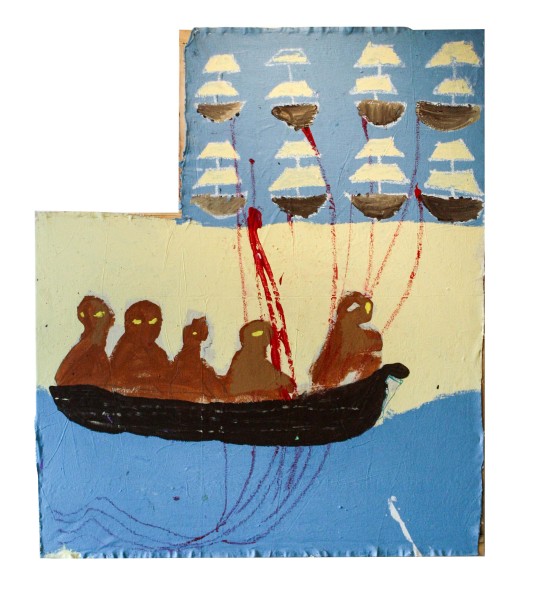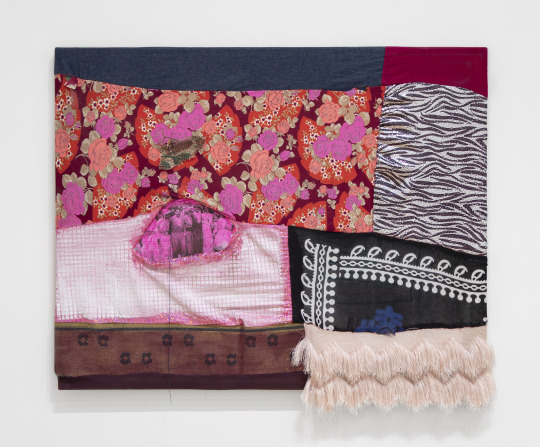#marlosevan
Explore tagged Tumblr posts
Text
26. Nuveen Barwari & Marlos E'van
Nuveen Barwari & Marlos E’van discuss their shared sense of immediacy and trust in the materials in their work, abstracting the figure, and the myriad influences that inform their art practices.

Nuveen Barwari (NB): Alright, where do we start? I guess I'll start by saying thanks for agreeing to do this with me. We have worked with each other for about five years on multiple projects and I think this is a great opportunity for us to really reflect on the common threads that both of our art practices share.
Marlos E’van (ME): I was really energized when you asked me to join you in this discussion, and I def want to thank you as well. It’s true, we have worked on multiple projects together and also personal work where we pass a piece back and forth over time, making a different move with each pass. Out of all the conversations we’ve had based on our work, this feels like the first time we’ve formally talked in public about the intersections our practices share both formally and conceptually!
NB: I think about the figures in your paintings, the way you handle paint, materials and multiplicity.… These are a few things that I would like to discuss with you in relation to my work…Maybe we can start off with this sense of “urgency” that I believe is present in both of our works. I want to say there is this sense of urgency in our work but our work is anything but that… I think the process actually involves a lot of research, conversations, and dwelling.. Maybe the execution feels quick… but the lead up to that initial mark making isn't quick at all.

Marlos E’van, Next Great Migration, 2020, oil, latex, oil stick on canvas, 50.5 x 50.75 inches
ME: That’s a good place to start. It’s true that sometimes our work has this feeling of immediacy to it which some might call “fast paced”, however, I agree that we both take our time to really dig in and think about our subjects and work it out in our heads through conversations, sketches, and reading articles/books. Once that research is done, we’ve pretty much worked out the piece in our head and go all in on the attempt which usually results in that fast pace. It feels like this urgency we share is reflective of the urgency involved in our subject matter.
NB: Yes, I agree with all of the above… also at the same time I feel like we are such “Makers'' with a capital M that even if we don't have a plan we are still making and trusting the process… that sounds cliche but its true sometimes i'll be in the studio surrounded by all of my materials and i have so much conviction in all of these materials that i have collected over the years that i know that regardless of a “plan”. Hmm how do I put this.. For example I can close my eyes and just pick out random materials in the studio and sew them together and trust that it will all come together later… I have definitely connected this sense of “urgency” in the past to protest and the subject matter so I'm glad you brought that up… I have also connected it with my use of the sewing machine and screen printing you know?

Nuveen Barwari, Landscape, denim, found fabric, deconstructed Kurdish dress, acrylic paint, fabric paint, thread, canvas, xerox paper, 32 x 40 inches, 2022
ME: Wow I like the way you put that! I think it’s important for people to know that there are situations where we take our time and research, sketch, etc, yet there are other times where we go with our instincts and go in without a “plan”. Moments like that allow us room to explore and let a piece guide us to its final composition. I feel like we both achieve this sort of “freestyle” by taking into account the materials, the natural and un-natural movements in the materials, and daily mark making on the piece. Sometimes in my work I just sit and stare at a canvas, noticing the shadows and marks that already exist. These observations help guide me into what moves I wanna make next. Kinda like playing chess.
NB: So I also see a connection between the way you abstract figures in your paintings and the way I abstract figures in my paintings. I think the way we both handle paint is very similar and some would even say is not very “traditional” for example some of my favorite moments in your work is when I see the paint on the raw canvas.
ME: You know, when it comes down to making figures, I never wanted to paint something exactly how you see it in life, that's boring for me. Therefore, I chose to make figures that allow us to make abstracted discoveries in the work. Moving body parts out of place and using my line work brings an element of fun to the creations which I feel your work does also. Speaking of paintings and abstract figures, I noticed that some people label your work as textile based paintings. However, both you and I refer to them as Paintings. You just showed me a new piece in your studio and it def reads as a huge painting although there’s no “paint” applied, yet you move around the material like a painter would. What are your thoughts on this and how do you actually see your work as far as being textile or paintings?
NB: I often tell people I am not a poet, I only hang out with them. I do call myself a painter though and almost everything I make is a painting. You see, I come from an academic painting background, everything I've learned from painting I've applied it to everything else I do in the studio whether that be installations, textiles,video work, performance, and even fashion.
To look at painting beyond the medium itself, to paint without paint is something I think about on a daily basis. I think it's really interesting how many associate the rectangle to painting while I associate it to rugs. And then I take the rug and connect it to a door which in the past has been literally utilized as a door and then I circle back and connect it to painting and it goes on and on. It involves a lot of contradictions that aren't always bad. I'm not gonna lie tho sometimes do insert my work into the painting realm very abruptly.

Nuveen Barwari, Cooking for the peshmergas, thread, deconstructed Kurdish dress, Xerox paper, 16 x 20 inches, 2022
ME: That's really interesting! I love that line where you say “to paint without paint”. In my own practice, I see myself as a sculptor or a filmmaker sometimes even if I'm making a painting. I also see myself as a musician at the same time; making these compositions that move in time like a musical arrangement. Sometimes the music goes from Jazz, Punk, Rap, and Goth, etc. However, I don't feel beholden to categorize anything I do as just one thing. I feel like that is another similarity we share.
NB: Yes I agree with you… both of our works involve multiplicity. I like that you mentioned music because that is definitely something I think about in the studio. Like I will listen to alot of Kurdish music and sometimes even pretend that I am making album covers for some of the greats or that I am hanging out with them in the studio… I also think about translation alot and connect that to multiplicity …I have always been mesmerized with the many ways Kurdish poets and musicians have employed language as a tool for resistance. The term “Gulistan” is a common motif in a lot of Kurdish songs and poetry. The flower of a rose is known as a "gul." All flowers are referred to as "gul" in conversation, however the correct word in Kurdish is "kulik." the complexities of using floral themes and metaphors to both reveal and conceal their ethnic identity. I'm really interested in the shapes and sounds that are found through translation rather than focusing on the stuff that is lost, you know? But I would love to talk to you more about the sculptural element in painting, since so many painters I know absolutely dread stretching their own canvases… and to me that is the best part.
ME: I feel you on that!
When it comes to the sculptural elements, I can remember one of my mentors, Terry Thacker, always talking about the act of pushing paint around on the surface. Before art school, I grew up on a farm and helped one of my uncles do home improvement jobs for people in our community back in Mississippi. We would always have to invent tools and improvise with materials. This almost always came in the form of a sculpture in some way. This carried over into my art making from how I use paint and materials, and how I build stretcher bars. I try to break from the traditional rectangle forms, something I'm aware that you do as well; and create alternative structures that challenge how we present and observe a work of art. This goes back to the note changes in music, while also incorporating a sculpture that holds a painting in place.

Marlos E’van, Fire and Spears, 2020, rope, oil, latex and oil sticks on canvas, found wood frame, 54 x 43.5 inches
NB: Ok cool. Oh wow yeah i like that… “the act of pushing paint” that even becomes performative as well. I'm glad you mentioned how growing up on the farm has informed alot of your art making because it has me thinking of growing up in Duhok, Kurdistan and being in awe of the colorful bazaars, fabric stores, and the landscapes. For instance, being part of a diasporic community entails this transcontinental exchange of materials from the homeland (home country) and host land (host country). Being a member of diaspora necessitates this almost constant exchange of materials from the homeland and the host land. This exchange consists of family from the homeland sending anything from photographs with written messages and dates on the back to honey, spices, and beautiful fabrics or the family in the host land sending photographs, clothes, medication, and in my case bags of hot Cheetos to the homeland. I've always been fascinated by the little things, like how much space would be added to the suitcase when a needle is used to poke tiny holes in hot Cheeto bags when traveling back home. I grew up watching elders in diaspora transplanting fig trees and rose bushes from the homeland into this new soil, making Kurdish dresses out of the fabrics that were available to them in the host land, and most importantly I witnessed the longing, the act of making a home away from home and the grief that comes with it.
ME: Wowow, I think this is a really important/intimate view into your artmaking and thought process. Very beautifully said! I know we can talk longer but folks will have to wait on our memoirs for more. Until then they can stay tuned in to what we’re making.
NB: Haha yeah i think this is a good stopping point. Thanks for the conversation.
ME: No prob and thank you! Now I'm about to go find something to eat! Talk 2 U Later!!

Nuveen Barwari was born in Nashville, TN (1995). Barwari received a Bachelor of Science in Studio Art from Tennessee State University in 2019 and a Master’s in Fine Arts from the University of Tennessee, Knoxville in 2022. Employing collage, painting, textiles, and installation, Barwari studies the intricacies within conditions of assimilation, material culture, and contradictions within diasporic identities. Barwari’s work has been featured in national and international publications including the Nashville Scene, New American Painting, Yahoo Nachrichten Deutschland, Gazete Duvar, and Botan Times. She has exhibited in numerous locations such as, Sugar Gallery (2019) in Fayetteville, Arkansas, Zg Gallery (2020) in Chicago, NGBK Gallery in Berlin Germany (2021), Duhok Gallery (2021) in Duhok, Kurdistan, and Ortega y Gasset Projects, in Brooklyn, NY (2022). Barwari is represented by The Red Arrow Gallery in Nashville, TN and is currently working and living in Albany, NY.
nuveenbarwari.com @nuveenbarwari
Marlos E'van (b. 1988 Tupelo, MS) Nashville-based artist, E'van interweaves different mediums such as painting, performance, and filmmaking to create worlds in which their art recollects black histories: joy, pain, celebration, sorrow, and complex emotions from reenacted scenes of American histories. A subtle vernacular in expression has caught recognition from such publications such as Hyperallergic and New Art Examiner. In addition to their work as an artist, E'van co-founded/co-designs M-SPAR, McGruder Social Practice Artist Residency out of the McGruder Center in North Nashville. Working as an educator in a hard-hit redlined Nashville neighborhood, E'van actively listens to their pupils, gathering stories that also inform E'van's paintings. Their own life creates first-person narratives in paintings targeting marginalization, stemming from a queer black history rooted in their home state of Mississippi. Marlos E'van's work is included in International collections, has been shown in VA, TN, GA, MS and NY.
@marlosevan
0 notes
Video
Woo! That's my parents in the background lol @fristartmuseum @Doughjoe @woke3 @omaribooker @onedropink @orgnzd.visuals @marlosevan https://www.instagram.com/p/B0UfUiMHJH4/?igshid=1ojtu0533u1r0
3 notes
·
View notes
Photo

NORTH NASHVILLE NOW Opening at @fristartmuseum this Friday August 10. Collection of Murals done by @queenbeeink @bdonahue1111 @norfstudios@omaribooker @[email protected] @nuveenbarwari@marlosevan @courtneyadairjohnson Thanks to @kdelmez https://www.instagram.com/p/B04nmS0pVJy/?igshid=1l9iskmy0bvg8
2 notes
·
View notes
Photo

Come see my installation tomorrow! Thanks @kelseywhatididthere . Last year we broke ground on 63 new affordable apartments at 26th & Clarksville. Next week we’ll cut the ribbon, unveil the killer @omaribooker mural, and sign some leases - which calls for a celebration. Come out Saturday and explore pop-up apartment galleries of @omaribooker @xpayneart @orgnzd.visuals @povertyandthearts @dwoodley3693 @sarah.hart.landolt @marlosevan @andresbustm and celebrate with @urbanhousingsolutions - we’ll see you there. #homeiswheretheartis #affordablehousing #communitydevelopment #nashville https://www.instagram.com/p/B2F_gf2JH1A/?igshid=gp4y1jk9w7nd
0 notes
